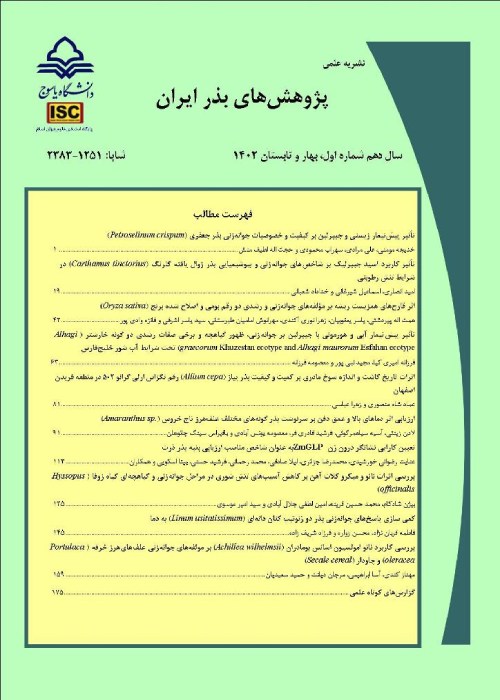Investigation of coleoptile and mesocotyl as the most important factors for the establishment of bread wheat seed under rain-fed conditions
Wheat coleoptile protects the plumule and the first leaf so they can move from the embryo to the soil surface. Coleoptile is essential for plant establishment. Cultivars with longer coleoptiles and mesocotyls are sown deeper and are more successful under drought stress conditions. However, there is not much information about their genetics. The objective of the present study was to evaluate the coleoptile and mesocotyl of Iranian, overseas and the lines developed as a part of Shahid Bahonar University breeding program, and estimate of genetic parameters of these traits.
In this research, 30 bread wheat genotypes originated from Iran, CIMMYT, ICARDA, USA, and Australia and five lines from Shahid Bahonar University of Kerman breeding programs were sown at a 10 cm depth of soil in the research field of Shahid Bahonar University in a randomized complete block design with seven replications. Each plot consisted of three rows with two meters long and a 5 cm intra-row spacing. At harvest, the plants were gently removed from the soil, and after removing the soil from the root area, the roots were washed. In this study, coleoptile and mesocotyl length, number of seminal roots, root length, root and shoot dry weight were measured.
Coleoptile and mesocotyl are important traits for increasing drought tolerance in bread wheat. In the present research, mesocotyl length varied from 5.20 for Excalibur to 2.08 for Zagros, and showed a high heritability (0.48) and response to selection (11.61%). Furthermore, this trait had a positive significant correlation with coleoptile length (r=0.53**), root weight (r=0.38*) and shoot weight (r=0.36*). Seminal and nodal root number had the highest (0.59), while root length had the lowest (0.13) narrow-sense heritability. Overall, suitable cultivars for rain-fed conditions had higher coleoptile and mesocotyl than the others. Breeding lines in Shahid Bahonar University of Kerman suitable for rain-fed conditions had longer coleoptile and mesocotyl lengths. Root and shoot dry weight had a significant positive correlation (r=0.82**).
In general, breeding programs to increase grain yield differ under rain-fed and irrigated conditions. In wheat breeding programs under rain-fed conditions, special attention should be paid to coleoptile and mesocotyl traits. These traits were not influenced by the plant growth habit.
Mesocotyl of the Iranian cultivars was evaluated for the first time.
Breeding lines developed by Shahid Bahonar University of Kerman suitable for rain-fed had appropriate coleoptiles and mesocotyls.
Coleoptile and mesocotyl had a significant and positive correlation.
- حق عضویت دریافتی صرف حمایت از نشریات عضو و نگهداری، تکمیل و توسعه مگیران میشود.
- پرداخت حق اشتراک و دانلود مقالات اجازه بازنشر آن در سایر رسانههای چاپی و دیجیتال را به کاربر نمیدهد.



